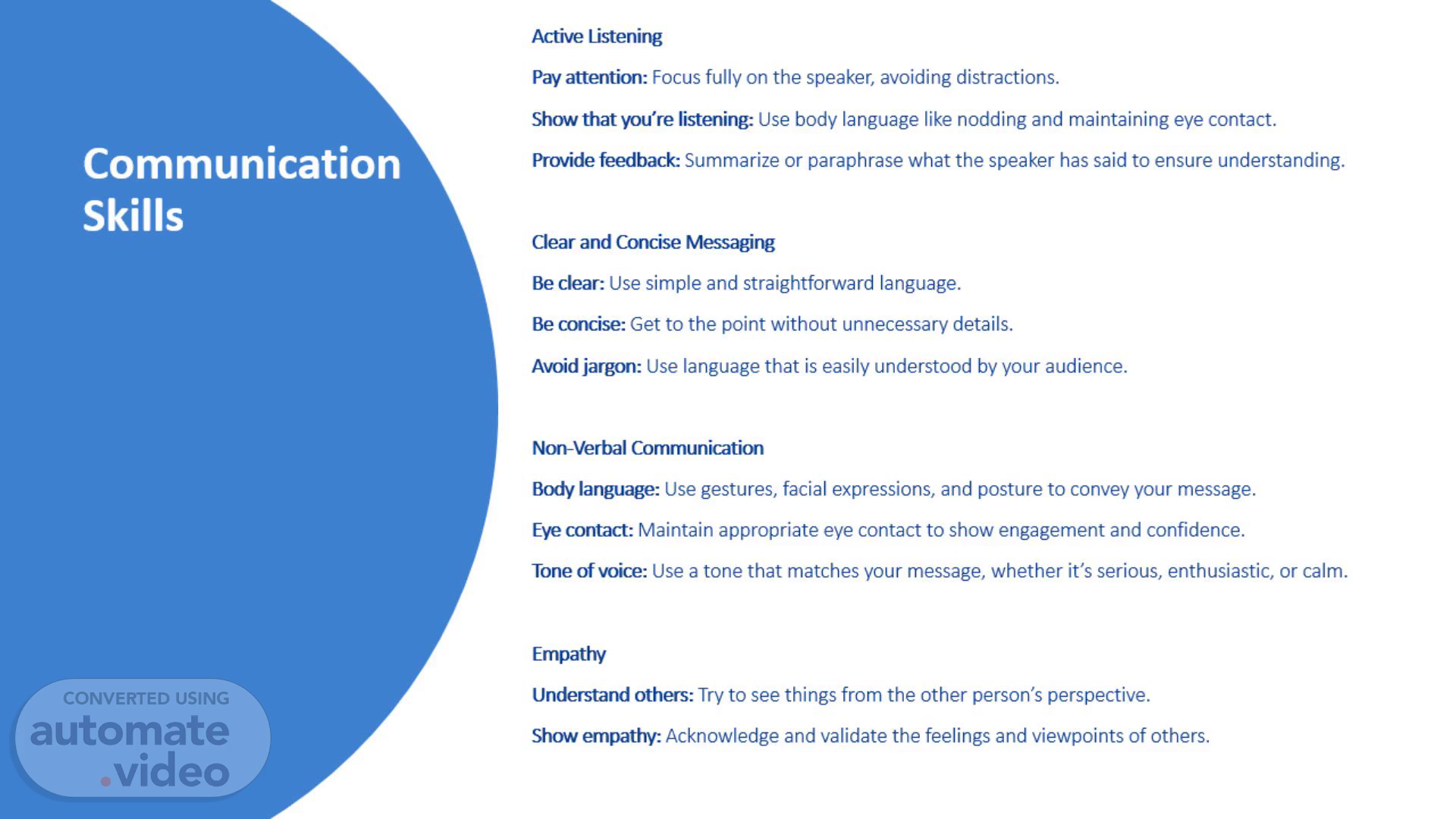Scene 1 (0s)
Communication Skills. Active Listening Pay attention: Focus fully on the speaker, avoiding distractions. Show that you’re listening: Use body language like nodding and maintaining eye contact. Provide feedback: Summarize or paraphrase what the speaker has said to ensure understanding. Clear and Concise Messaging Be clear: Use simple and straightforward language. Be concise: Get to the point without unnecessary details. Avoid jargon: Use language that is easily understood by your audience. Non-Verbal Communication Body language: Use gestures, facial expressions, and posture to convey your message. Eye contact: Maintain appropriate eye contact to show engagement and confidence. Tone of voice: Use a tone that matches your message, whether it’s serious, enthusiastic, or calm. Empathy Understand others: Try to see things from the other person’s perspective. Show empathy: Acknowledge and validate the feelings and viewpoints of others..
Scene 2 (41s)
[Audio] Feedback Give constructive feedback: Offer specific, actionable suggestions for improvement. Receive feedback: Be open to receiving feedback and use it to improve your communication skills. Adaptability Adjust your style: Tailor your communication style to suit different audiences and situations. Be flexible: Be willing to change your approach based on the feedback and the context. Confidence Be assertive: Express your ideas and opinions confidently and respectfully. Avoid aggression: Be firm but not aggressive in your communication. Respect Be respectful: Show respect for others’ opinions and feelings. Avoid interrupting: Let others finish speaking before you respond. Communication skills.
Scene 3 (1m 31s)
[Audio] Enhances Learning Effectiveness Understanding learning styles allows trainers to tailor their methods to meet the diverse needs of their audience. This customization can significantly enhance the effectiveness of the training, ensuring that all participants are engaged and able to absorb the material. Increases Engagement and Participation When training sessions are designed to cater to different learning styles, participants are more likely to stay engaged and participate actively. This leads to a more dynamic and interactive learning environment, which can improve retention and understanding of the material. Builds Confidence and Motivation When learners feel that the training is designed with their needs in mind, they are more likely to feel confident and motivated. This positive attitude can lead to better performance and a greater willingness to engage with the training material. Enhances Trainer Effectiveness Trainers who understand learning styles can adapt their teaching methods to be more effective. This adaptability can lead to better outcomes for both the trainer and the participants, as the training sessions become more responsive to the needs of the learners. Why Understanding Learning Styles is Important in Training November 5, 2024 Presentation name | Author | CONFIDENTIAL / INTERNAL.
Scene 4 (2m 54s)
[Audio] Advantages: Learn best through seeing. Good at remembering visual details. Often have strong spatial awareness. Disadvantages: May struggle with verbal instructions. Can be easily distracted by visual clutter. Best Methods to Convey Information: Use diagrams, charts, and graphs. Incorporate videos and infographics. Provide written instructions and handouts. Use color coding to highlight key points. Visual Learners November 5, 2024 Presentation name | Author | CONFIDENTIAL / INTERNAL.
Scene 5 (3m 34s)
[Audio] Advantages: Learn best through listening. Good at remembering spoken information. Often excel in discussions and oral presentations. Disadvantages: May struggle with written instructions. Can be distracted by background noise. Best Methods to Convey Information: Use lectures and group discussions. Incorporate audio recordings and podcasts. Encourage verbal repetition and summarization. Use mnemonic devices and rhymes. Auditory Learners.
Scene 6 (4m 9s)
[Audio] Advantages: Learn best through hands-on activities. Good at remembering actions and physical tasks. Often excel in physical activities and experiments. Disadvantages: May struggle with traditional lecture-based learning. Can be restless and need frequent breaks. Best Methods to Convey Information: Use hands-on activities and experiments. Incorporate role-playing and simulations. Allow for movement and frequent breaks. Use physical objects and models to explain concepts. Kinesthetic Learners.
Scene 7 (4m 45s)
[Audio] Advantages: Learn best through reading and writing. Good at organizing information in written form. Often excel in note-taking and research. Disadvantages: May struggle with purely auditory or visual information. Can be overwhelmed by large amounts of text. Best Methods to Convey Information: Provide detailed written instructions and handouts. Encourage note-taking and journaling. Use lists, headings, and bullet points to organize information. Incorporate reading assignments and written exercises. Reading/Writing Learners.
